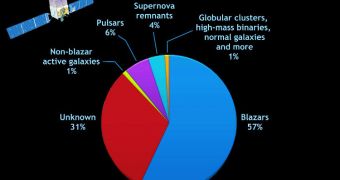On September 9, participants at the American Astronomical Society's High Energy Astrophysics Division meeting in Newport, Rhodes Island, were treated to the conclusions of the newest, yearly report of cosmic gamma-ray sources compiled by the NASA Fermi Gamma-ray Space Telescope.
The instrument, which is capable of scanning the entire sky once every three hours, is constantly on the look-out for high-energy events taking place throughout the Universe. Every year, scientists managing the mission compile all the data into a comprehensive catalog, whose results they then publish.
Using updated analysis methods, researchers go back over the same data every year, looking for correlations and phenomena that they may have missed on previous instances. This approach, though time-consuming, works very well for identifying new radiation sources.
The Large Area Telescope (LAT) – the main instrument aboard the observatory – provided sufficient data earlier this year for the creation of Fermi's second annual catalog. Some 1,873 high-energy objects were detected and cataloged by the Fermi science team.
“More than half of these sources are active galaxies, whose massive black holes are responsible for the gamma-ray emissions that the LAT detects,” University of Perugia astrophysicist Gino Tosti explained. He is now a visiting scientist at the SLAC National Accelerator Laboratory, in Menlo Park, California.
The expert was also the one who presented the most recent findings at the HEAD meeting. “What is perhaps the most intriguing aspect of our new catalog is the large number of sources not associated with objects detected at any other wavelength,” he told attendants.
As evidenced by the pie chart on the left, the high-energy Universe is mostly composed of blazars – very compact quasars associated with supermassive black holes at the centers of active, giant elliptical galaxies – and mysteries.
Current theories cannot account for about 31 percent of the high-energy radiation that Fermi discovered over the last year. Small percentages of these sources are accounted for by globular cluster, binaries, massive galaxies, pulsars, active galactic nuclei and supernova remnants.
What is immediately transparent from the new data is that astrophysicists still have a long way to go before being able to compile comprehensive theories. There are still numerous aspects of the Universe that we don't understand, even in areas were we thought we had things more or less figured out.
Experts are now faced with the prospect of discovering new types of gamma-ray sources among the 31 percent of unassociated sources Fermi discovered. However, before any study can be set into motion, scientists need to hypothesize on what these objects might be.

 14 DAY TRIAL //
14 DAY TRIAL //